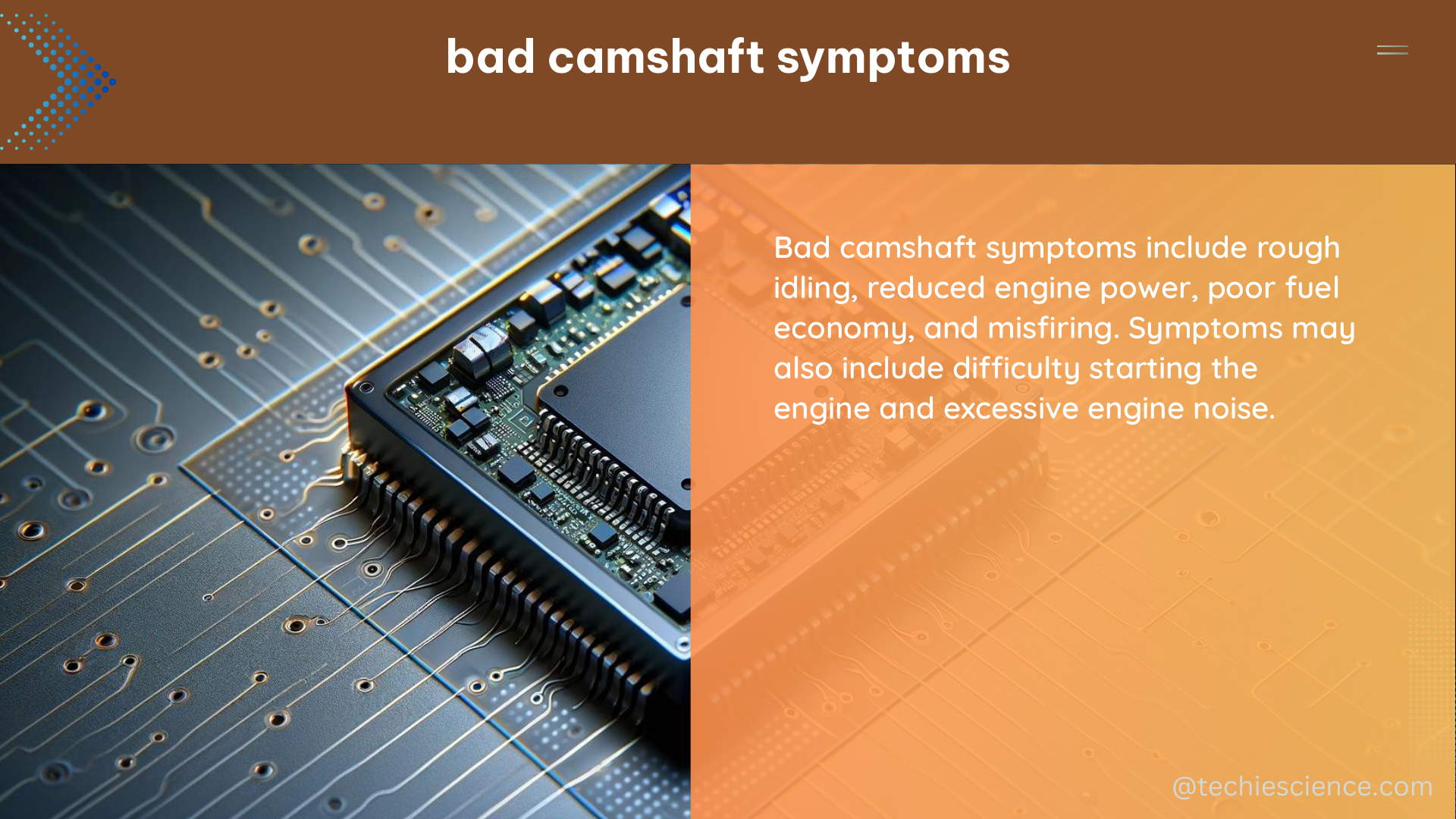A malfunctioning camshaft can lead to a range of issues in your vehicle, from reduced engine performance to increased emissions and even catastrophic engine failure. Understanding the various symptoms of a bad camshaft is crucial for timely diagnosis and repair. In this comprehensive guide, we’ll delve into the technical details and provide a step-by-step approach to identifying and addressing bad camshaft symptoms.
Mechanical Failure Symptoms
Loud Ticking or Tapping Sounds
One of the most common signs of a mechanical failure in the camshaft is the presence of loud ticking or tapping noises. These noises are often linked to worn cam lobes, which can result in metal debris circulating through the engine. The severity of the noise can vary depending on the extent of the wear, with more severe wear causing louder and more persistent tapping sounds.
Cylinder Misfire
A vehicle with a damaged camshaft may suffer from reduced engine performance due to cylinder misfire. This can manifest in various ways, including hesitation, loss of power, aggressive jerking or shaking, increased fuel consumption, and higher emissions. The severity of the misfire can depend on the degree of camshaft damage and the number of affected cylinders.
Visible Signs of Damage
In some cases, you may be able to visually inspect the camshaft and other valvetrain components for signs of wear or damage. This can include pitting, scoring, or even complete breakage of the cam lobes. Careful inspection of these components can provide valuable insights into the root cause of the problem.
Increased Emissions
A worn camshaft can lead to an engine misfire, which in turn, causes an increase in tailpipe emissions. This can be detected through emissions testing or by observing a noticeable change in the vehicle’s exhaust output.
Sensor Failure Symptoms

Check Engine Light
The check engine light is a common indicator of a potential problem with the camshaft or its associated sensors. When the vehicle’s computer detects an issue that may lead to increased emissions, the check engine light will illuminate. To diagnose the specific problem, you’ll need to connect the vehicle to an OBD (On-Board Diagnostics) scan tool to retrieve the stored trouble codes.
Poor Drivability
A failing camshaft position sensor begins losing its ability to quickly and accurately transfer data to the engine control module (ECM). This can result in mismatched fuel delivery and ignition timing, even if the discrepancy is only a few milliseconds. This can cause the vehicle to sputter, accelerate poorly, lack power, stall, or even shut off completely.
Transmission Shifting Problems
The data received by the ECM from a failing camshaft position sensor can also affect the operation of the transmission. This can keep the transmission shift solenoids from functioning properly, leading to issues with gear shifting. Some vehicles may enter a “limp-home-mode” to protect the engine from further damage by restricting engine speed.
Technical Specifications for Bad Camshaft Symptoms
Lobe Wear
The most common cause of camshaft failure is poor maintenance and lack of lubrication, which can lead to excessive wear on the cam lobes. This wear can result in a loss of valve lift and timing, ultimately affecting engine performance. Typical lobe wear can range from 0.001 to 0.010 inches, with more severe wear requiring camshaft replacement.
Lobe Separation
In some cases, the lobes of the camshaft can separate from the shaft itself, causing catastrophic engine failure. This type of failure is often the result of a manufacturing defect or severe overloading of the camshaft.
Cam Journal Wear
Wear on the cam journals, which are the surfaces on which the camshaft rides inside the engine, can also contribute to camshaft failure. Excessive journal wear can lead to increased clearance and reduced lubrication, ultimately causing the camshaft to seize or break.
Cam Phaser Problems
Cam phasers are used in modern engines to provide variable cam timing, which can improve engine efficiency and performance. Issues with these components can also lead to camshaft-related problems, such as reduced engine power, increased fuel consumption, and even engine stalling.
DIY Diagnosis of Bad Camshaft Symptoms
Check Engine Light Diagnosis
When the check engine light illuminates, the first step is to connect the vehicle to an OBD scan tool to retrieve the stored trouble codes. These codes can provide valuable information about the specific problem, such as a camshaft position sensor failure or a camshaft-related misfire.
Visual Inspection
Carefully inspect the camshaft and other valvetrain components for visible signs of wear or damage, such as pitting, scoring, or breakage. This can help identify the root cause of the problem and guide the repair process.
Listening for Unusual Noises
Pay close attention to any unusual ticking, tapping, or knocking noises coming from the engine. These sounds can be a clear indication of a problem with the camshaft or its associated components.
Monitoring Engine Performance
Keep a close eye on the vehicle’s overall performance, including power delivery, fuel consumption, and engine smoothness. Any noticeable changes in these areas may be a sign of a camshaft-related issue.
By following these steps and understanding the technical details of bad camshaft symptoms, you can effectively diagnose and address any issues with your vehicle’s camshaft, ensuring optimal engine performance and longevity.
References:
- Cam Lobe Failure Analyses
- Common Symptoms of Bad Camshaft Position Sensor (CMP)
- Camshaft Position Sensor Symptoms
- What Are the Symptoms of a Bad Camshaft? 6 Signs to Watch Out For
- Need help finding symptoms of camshaft failure

The lambdageeks.com Core SME Team is a group of experienced subject matter experts from diverse scientific and technical fields including Physics, Chemistry, Technology,Electronics & Electrical Engineering, Automotive, Mechanical Engineering. Our team collaborates to create high-quality, well-researched articles on a wide range of science and technology topics for the lambdageeks.com website.
All Our Senior SME are having more than 7 Years of experience in the respective fields . They are either Working Industry Professionals or assocaited With different Universities. Refer Our Authors Page to get to know About our Core SMEs.